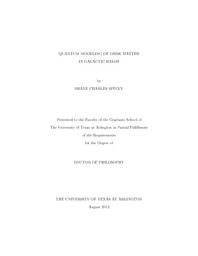
ATTENTION: The works hosted here are being migrated to a new repository that will consolidate resources, improve discoverability, and better show UTA's research impact on the global community. We will update authors as the migration progresses. Please see MavMatrix for more information.
Show simple item record
| dc.contributor.author | Spivey, Shane Charles | en_US |
| dc.date.accessioned | 2013-03-20T19:10:46Z | |
| dc.date.available | 2013-03-20T19:10:46Z | |
| dc.date.issued | 2013-03-20 | |
| dc.date.submitted | January 2012 | en_US |
| dc.identifier.other | DISS-11806 | en_US |
| dc.identifier.uri | http://hdl.handle.net/10106/11515 | |
| dc.description.abstract | Eighty years after its initial discovery, the nature of dark matter remains a mystery. Contrary to observational evidence, simulations of dark matter halos predict cuspy density profiles and an abundant population of dwarf galaxies. Increasingly refined measurements of the dark matter halos in galaxies reveal a large variety of halo shapes and sizes, and so far no universal profile has been able to incorporate them all. Among the numerous dark matter candidates, models of so-called quantum cold dark matter (QCDM) have the unique potential to address the many disparities between theory and observation.QCDM postulates that dark matter is composed primarily of extraordinarily light (as small as m 10-24 eV) bosonic particles. Such a small mass suggests a Compton wavelength on the order of parsecs, motivating the use of quantum mechanics on a galactic scale. Since dark matter by definition has no electromagnetic interaction, QCDM particles are bound to the lowest energy state of the galactic halo by a collectively-produced gravitational potential in the Schrodinger equation. Thus in the first approximation a QCDM halo has the properties of a Bose-Einstein condensate, and the entire halo can be described by a single wave function.In this dissertation, previous models of QCDM are reconsidered and compared to the most recent observational evidence. A comprehensive model for QCDM is then developed for a closed gravitational Schrodinger-Poisson system using the Hartree approximation. It is shown that the ground state solution to this system is well-approximated by an Einasto density profile with a shape parameter n ~ 0.56, which is a smooth-cored distribution.The model is then expanded to include the influence of galactic baryonic matter distributions and the effects of a scattering potential, as well as excited and mixed-state dark matter halos. The addition of a black hole to the galactic potential is shown to produce a more concentrated halo with a cuspier core. The inclusion of a small-scale luminous matter distribution also concentrates the halo, while a large-scale distribution diffuses it; in either case the smooth core of the halo is preserved. The addition of a scattering term produces a rounder and more diffuse density profile; adding a sufficiently large black hole in combination with this term results in an even cuspier profile than the black hole alone. As a result of these additions, the model can be applied to a much larger range of halo shapes and sizes. Including excited states expands this range even further.A comprehensive analysis of the theoretical framework is also presented, including a fully analytic power series solution to the gravitational Schrodinger-Poisson system. Finally, the Einasto density profile used as a fit for both simulated and observed dark matter halos is examined in depth, with emphasis on its significance to the models presented herein. | en_US |
| dc.description.sponsorship | Musielak, Zdzislaw | en_US |
| dc.language.iso | en | en_US |
| dc.publisher | Physics | en_US |
| dc.title | Quantum Modeling Of Dark Matter In Galactic Halos | en_US |
| dc.type | Ph.D. | en_US |
| dc.contributor.committeeChair | Musielak, Zdzislaw | en_US |
| dc.degree.department | Physics | en_US |
| dc.degree.discipline | Physics | en_US |
| dc.degree.grantor | University of Texas at Arlington | en_US |
| dc.degree.level | doctoral | en_US |
| dc.degree.name | Ph.D. | en_US |
Files in this item
- Name:
- Spivey_uta_2502D_11806.pdf
- Size:
- 1.650Mb
- Format:
- PDF
This item appears in the following Collection(s)
Show simple item record


